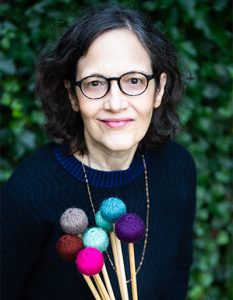PAS Hall of Fame:
Nancy Zeltsman
(b. 1958 )
by Rick Mattingly

Beverley Johnston will never forget Nancy Zeltsman’s performance at the Marimba 2010 International Festival and Conference in Minneapolis, where Nancy played some of the solo marimba repertoire she had commissioned over the years. “I was impressed with Nancy’s no-nonsense approach to playing the marimba and her thoughtful interpretation of the music at hand,” Johnston wrote in her letter supporting Zeltsman’s nomination to the PAS Hall of Fame. “Nancy was the conduit through which the music was being made. It was ALL about the music — no pyrotechnics, as with some of the other performances, but pure musicianship and a feeling, for me, of the importance of having some of the world’s finest composers writing for the marimba.”
Zeltsman has premiered over 130 solo and chamber music compositions, including pieces by Gunther Schuller, Steven Mackey, Robert Aldridge, Louis Andriessen, Michael Tilson Thomas, pop legend Paul Simon, and jazz composers/pianists Lyle Mays and Carla Bley. Alejandro Viñao and Paul Lansky both wrote their first marimba compositions for Nancy, followed by many others.
According to Zeltsman, “My approach to the marimba has evolved from the feeling that it’s my voice. As I’ve become a very active teacher, that has expanded to wanting to be the marimba’s advocate: to convey what I think the marimba wants to say about itself. This encompasses the various ways the marimba is played — which could, hopefully, be as numerous as the people playing it — and the different approaches of composers writing for it. Skilled, imaginative composers who thoughtfully consider the nature of the marimba’s voice can lead players to understand more possibilities than we might arrive at on our own.
“My greatest passion with regard to the marimba is elevating sound quality and projection of the fundamental pitch, which is so often lacking in the bass register, as well as considering the ways dynamic control enhances phrasing, musical expression, balances between lines and chords, and one’s tone. Control of dynamics and balances on marimba is as, or more, complex as on any other instrument.
“I choose to play ‘good music’ of many styles that speaks to my sensibilities, is harmonically rich, has space in it (‘Ma’ in Japanese), is quite often on the quiet side, and is a vehicle for portraying sounds where the marimba — the wood! — shines and basks and reveals its heights and, especially, its fabulous depths.”
Born in 1958 in Morristown, New Jersey, Nancy Zeltsman’s involvement with music began at age five with ballet and piano lessons. After a year, she stopped ballet but continued piano lessons until age 14. By age eight, she knew music was her calling, but she wasn’t convinced that piano was “her” instrument. Near the end of her elementary school days, the band director from the junior high Nancy would attend the following year suggested that Nancy try playing percussion at a summer band camp and, if she liked it, she could join the junior high band as a percussionist in the fall. “The first day at the camp I played timpani and was absolutely hooked,” Zeltsman says. “That’s it; I’m a percussionist!”
She began studying percussion with Juilliard graduate Robert Ayers. When Nancy was in tenth grade, Ayers suggested that she take lessons with xylophone virtuoso Ian Finkel. Zeltsman continued studying timpani and percussion weekly with Ayers, and took a two-hour lesson every other week with Finkel. She recalls that a typical lesson assignment for Finkel consisted of a violin concerto on xylophone with two mallets; and with four mallets, six pages of chordal guitar music on marimba, and six pages of David Friedman’s book Vibraphone Technique: Dampening and Pedaling. “It was entirely different material every two weeks — which continued for two years! It was a ridiculous amount of music to learn, but I became pretty fearless about sight-reading and learning most anything.” Although Finkel had her devote equal time to xylophone, marimba and vibes, Nancy gradually was drawn to marimba as her main focus.
But she still was very interested in all percussion and especially loved timpani. Nancy achieved her years-long dream to study with Vic Firth at New England Conservatory. She wanted to “soak up everything possible from Vic about his concepts of sound, color, projection, rhythm, clarity, musical style, and techniques to achieve those.” Midway through her college career, Zeltsman was a percussionist/Fellow at the Tanglewood Music Center one summer, then she took a year off from school, moved to New York, and worked in record and sheet music stores before returning to New England Conservatory. Zeltsman considered herself pretty much self-taught as a marimbist from the start of college. In her senior year, Firth consented to lessons being on marimba exclusively. “I mostly brought in adaptations of pieces Vic didn’t know, but I really valued his ideas about phrasing and musical style,” said Nancy. She also studied composition with William Thomas McKinley.
Nancy worked at Gunther Schuller’s publishing companies for more than eight years. But her first job after earning her Bachelor of Music degree from NEC was at a natural foods store. A regular customer was composer Robert Aldridge, and he and Nancy struck up a friendship. He was part of a group called Composers in Red Sneakers who put on chamber music concerts, an association Nancy feels put her on her path. Aldridge’s “Combo Platter” for violin, alto saxophone, and marimba would be the piece through which Aldridge introduced Nancy to violinist Sharan Leventhal. “The first time Sharan and I rehearsed together, we super-connected musically in a way I had never connected with anybody,” Nancy says.
Zeltsman had become very interested in playing marimba in chamber-music settings with other instruments. While studying improvisation with Dave Samuels, she formed an octet combining jazz and classical players with repertoire that would cross over into each other’s territory. Meanwhile, she and Leventhal formed the duo Marimolin. One of their goals was to commission works for or including marimba and violin. Marimolin was active from 1985–96, and again from 2015 to the present. In that time, they have premiered 83 works and sponsored an international composition contest that attracted nearly 200 entries over eight years. Many of the works they commissioned/premiered were released on three CDs: Marimolin, Phantasmata, and Combo Platter.
“My approach to sound quality developed a lot from playing with Marimolin,” Nancy says. “Composers would designate that Sharan play with a variety of articulations and coloristic devices, and I would think, ‘She has all these different ways to put a spin on what she’s playing; I want to do that too!’ In mixed chamber music, it’s also fun to cross-fertilize and imitate how you each make sound.”
In addition to her recordings with Marimolin, Zeltsman has recorded three solo CDs (Woodcuts, See Ya Thursday, and Sweet Song) as well as two marimba-duo CDs with Jack Van Geem — Nancy’s other main musical partner — and one featuring marimba-four-hands music of Daniel Levitan. In addition, she played on the soundtrack of the film Men with Guns and recorded William McKinley’s Marimba Concerto “Childhood Memories” with the Boston Modern Orchestra Project.
Ray Dillard, who produced Zeltsman’s solo recordings, commented, “Having produced a significant number of percussion records, I consider Nancy’s projects to be of the highest artistic quality. They always feature significant and often premiere recordings of highly important pieces that become standard works in the modern marimba repertoire. This fact cannot be overstated.”
Starting in 1993, Berklee College of Music and The Boston Conservatory (now Boston Conservatory at Berklee) created positions for Nancy to teach marimba as a specialty. Zeltsman served as Chair of the Percussion Department at Boston Conservatory from 2005–17, and she has coached chamber music groups and marimba ensembles at both schools. Her students have included such now-prominent players as Nanae Mimura, Fumito Nunoya, Pius Cheung, Eriko Daimo, Casey Cangelosi, Jonathan Singer, Keiko Kotoku, Anne-Julie Caron, Brian Calhoon, Rachel Xi Zhang, Laurent Warnier, Weichen Simon Lin, Brandon Ilaw, and Ayami Okamura.
She has taught master classes and private lessons one to two weeks a year at the Conservatorium van Amsterdam in the Netherlands as guest professor of marimba, and at the University of Michigan School of Music, Theatre and Dance as a Guest Artist.
“I love how personal teaching is,” Nancy says. “The music people work on and dream of playing, and what kind of life they want in music, reveals their core excitements in life. It’s thrilling and very precious for me to be along for the ride, or maybe even be an entrusted guide for that.”
Zeltsman says that some others’ approaches to teaching are based on, “Let’s get your technique together and then we’ll play some music.” She says that philosophy always seemed strange to her. “I believe that technical issues are best considered in service of musical goals,” she explains. “I try to get students to dream about where they want to take a piece from the beginning so that, ideally, all their playing feels like music-making.”
Nancy says that many developing players she has worked with don’t pay enough attention to their control of dynamics and balances. “Maybe this is because the marimba is so incredibly user-friendly,” she speculates. “Anyone who can hold a mallet can make a tone, and maybe even a fairly nice one. So the music can easily float into being purely rhythmic, or ‘contact’-based. We need to pay more attention to the myriad ways that one can produce sounds.
“The sound properties of the lower range of the marimba have to inform how you play the full range of the instrument,” she believes. “I came to my understanding of the bass register through Gunther Schuller’s ears — in his role of conductor, record producer, and especially composer. He was adamant about the necessity for the fundamental pitch to be strong and clear. A student performing for Gunther asked him how loudly a particular note that had a marcato accent should be played. Gunther replied, ‘Well, no louder than it isn’t still the pitch that I wrote!’ When the student played too loudly, extra upper partials — pitches Schuller hadn’t written — were evident to his refined ears.
“Sometimes in Marimolin rehearsals,” Nancy adds, “Sharan would struggle to hear a bass marimba pitch to which she needed to tune, until I changed to a softer mallet that brought out the fundamental pitches of the lower tones. Then she instantly, happily heard it!”
In 2001, Nancy inaugurated the Zeltsman Marimba Festival (ZMF). The two-week festival, which ran 14 times over an 18-year period, was held in a variety of locations across the U.S. and once in Amsterdam. Each festival drew 40–50 participants, and each year the faculty included eight to twelve international artists. In addition, there were ZMF On Tour mini festivals in Japan, China, Luxembourg, and Boston between 2014 and 2018. All told, Nancy estimates these events were attended by about 600 participants.
Mike Truesdell was Nancy’s assistant at ZMF for close to a decade. “We had four-hour or longer phone calls, meetings that crept into the early-morning hours, and panicked logistical frenzies,” he recalls. “Through these close interactions, I learned about Nancy the person. I cannot think of anyone who cares as much about other people as Nancy. In the same way that she will spend hours excavating the nuance of a particular note in a phrase, she will spend similar energy trying to connect with her students, audience members, and colleagues. Nancy is a guiding light for all of us who strive for progress, development, and connection to each other and the music we love.”
An offshoot of the festival was ZMF New Music, which fostered the composition of 24 intermediate-level marimba solos: 16 commissioned from major composers and eight selected as winners of an international contest, funded by over 200 contributors. Those compositions were published by C.F. Peters Corporation in a two-volume collection titled Intermediate Masterworks for Marimba. Recordings of the entire collection by Zeltsman, Jack Van Geem, Gordon Stout, William Moersch, Beverley Johnston, Jean Geoffroy, Thomas Burritt, and Ivana Bilic were released by Bridge Records.
“The spark of the idea for ZMF New Music came when I had lunch with a former student, who mentioned the need for excellent intermediate marimba solos to fill the gap between lighter, educational pieces and longer, advanced works,” Nancy recalls. “Instantly, I thought we needed a collection — not just one or two pieces. I brought the idea to the ZMF board, and they supported it. Shawn Michalek became an equal partner in pulling off what was an enormously demanding and fascinating project.”
In 2003, Hal Leonard Corporation published Nancy’s method book, Four-Mallet Marimba Playing. In the book’s Introduction, Zeltsman writes, “It is impossible to really grow as a musician without playing a lot of music.” While the book contains guidelines for mallet selection, four-mallet grip, tone production, phrasing, and other topics relevant to becoming a successful marimbist, the bulk of the book consists of 50 musical etudes Nancy composed, 18 adapted solos appropriate for recitals, auditions, or juries, and advice on examples from the solo and chamber music repertoire for marimba.
Gregory Beyer says that Four-Mallet Marimba Playing “completely transformed my own technical concept and teaching at the marimba. The book’s well-written and thoughtfully detailed descriptions of grip, articulation, sticking, phrasing, and a myriad other technical and musical considerations have laid the groundwork for my ability to guide my own students with confidence and clarity.”
Zeltsman has served as adapter/editor for two pieces for marimba duo published by Edition Svitzer: Debussy’s “Danse” and Barber’s “Adagio.” Edition Svitzer also publishes two pieces composed by Nancy: “Black Velvet” for solo marimba and “Quatre/Quatre” for solo timpani.
Nancy served four times on the jury of the biennial Tromp Percussion Competition in Eindhoven, the Netherlands, as well as competitions run in Belgium and Paris, and by Southern California Marimba and PAS.
She has been very involved with PAS over the years. She has written several articles for Percussive Notes, starting in 1997, served as Keyboard Editor for Percussive Notes from 1999–2002, and was featured in a Percussive Notes cover story in May 2013. She performed at PASIC with Marimolin in 1988, 2003, and 2017, and has presented concerts and clinics at nine other PASICs. In 2009, eight compositions from Intermediate Masterworks for Marimba were performed at a showcase concert. Nancy has also appeared at numerous PAS state Days of Percussion. She judged the PAS Marimba Composition Contest in 2019 and serves on the PAS Keyboard Committee.
“I’ve particularly enjoyed performing at PASIC!” she says. “I also love attending PASIC to catch up with special friends — slipping away for quiet quality-time conversations as often as possible while still catching some great performances and other events.”
Nancy calls her induction into the PAS Hall of Fame “an enormous honor.” She speculates that the recognition is the result of her heeding something Ian Finkel told her when she was about 17. “Understanding I was intent on heading off to training at a conservatory, Ian told me, ‘There is nothing wrong with being a well-rounded percussionist, if that’s what you love. But if you want to take a single instrument to another level, you have to specialize on it.’ That really resonated with me, because I saw where he went as a xylophonist, and I thought I had a chance to do that with marimba, which was rare at the time. So I went at it pretty hard. Also, when I emerged on the scene, it was as a chamber musician, not a soloist, and that was unusual.”
“I owe a lot to the work ethic I learned from Ian Finkel and Gunther Schuller. We all just put one foot in front of the other and do our work — for the love of music — and hope it adds up to something meaningful,” she concludes.
RESOURCES
Website: www.nancyzeltsman.com
Percussive Notes articles about Nancy Zeltsman
“Marimolin Celebrates Past Commissions,” Vol. 55, No. 4 (Sept. 2017)
“Nancy Zeltsman: The Power of Nuance,” Vol. 51, No. 3 (May 2013)
Percussive Notes articles written by Nancy Zeltsman
“Inside a Marimba Competition,” Vol. 37, No. 5 (Feb. 2002)
“Commissioning New Music,” Vol. 37, No. 5 (Oct. 1999)
“Musings on the Marimba and Its Study, 1997, Part 1,” Vol. 35, No. 5 (Oct. 1997)
“Musings on the Marimba and Its Study, 1997, Part 2,” Vol. 35, No. 6 (Dec. 1997)









